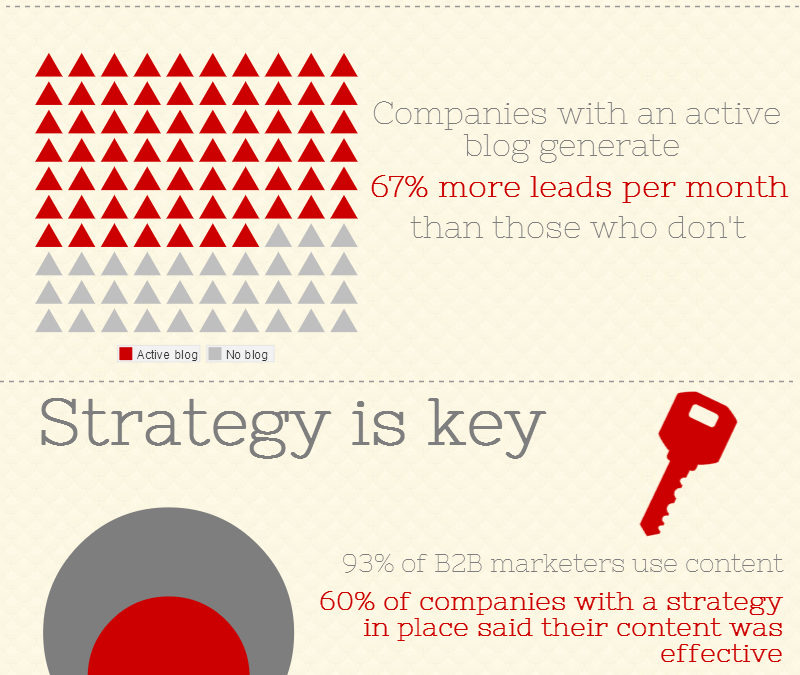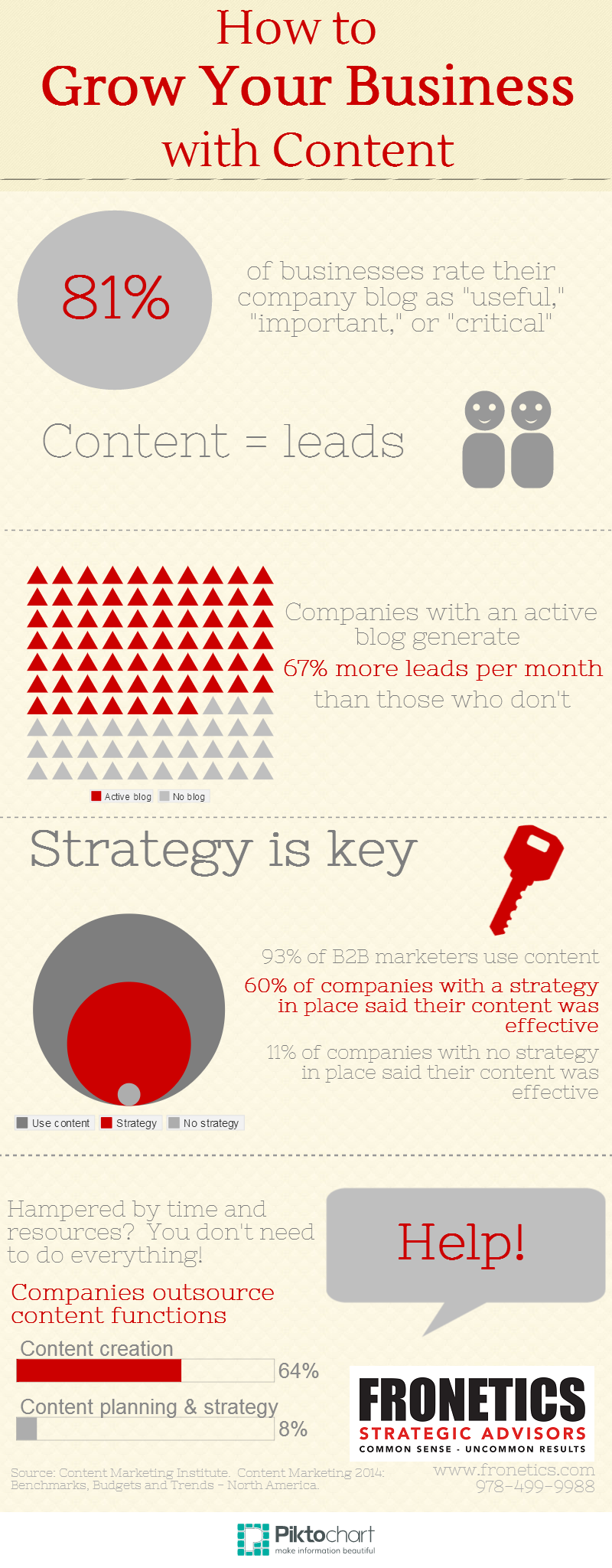by Fronetics | May 15, 2014 | Blog, Consumer Electronics, Content Marketing, Marketing, Social Media, Strategy, Supply Chain
Curating content is an essential component of your content strategy and to demand generation. Content curation can help you grow your business by establishing your business as a thought-leader within the industry and as a trusted resource.
Here are four factors to doing content curation successfully:
Know your audience
Identify your audience. In many cases your target audience is your company’s buyer persona.
Take the time to know your audience. For example, take the time to understand what type of information and/or resources they are likely to be looking for, learn what platform(s) they are most likely to use (e.g. Twitter, LinkedIn, Facebook), learn their interests, and learn their passions.
Be relevant
Curate content that is relevant to your audience. The content you curate should provide your audience with value and knowledge.
Quality, quality, quality
Content can be stuff. Content can be clutter. If you want the content your business curates to stand out, you make sure the content you curate is quality – every time. Quality is a differentiator.
Be consistent
Share content on a regular and consistent basis. This will not only increase your visibility, but it will also establish you as a trusted resource – as the go-to resource for information and for knowledge.
This article also appeared on DC Velocity.
by Fronetics | May 12, 2014 | Blog, Content Marketing, Marketing, Social Media, Strategy
Adam Robinson of freight logistics company Cerasis wrote a series of posts which outlined the company’s social media and content marketing strategy and the successes the company has achieved through the execution of their strategy. The series also included how-to guides: how to create a social media and content marketing strategy and how to execute a social media and content marketing strategy. Robinson’s series is a must read for companies interested in learning the potential business value of a social media and content marketing strategy and for companies wondering the steps they need to take to create and execute a successful strategy.
Two sentences in Robinson’s series stand out:
“It all comes down to strategy!”
“Now, if you have the resources to be on every social media platform, you should, but only if you do it well!”
Sage advice.
Without a strategy it is unlikely that your company will be successful. Social media and content marketing can be effective tools for attracting new customers and retaining current customers; however, it is unlikely that your company will reap these benefits if you do not have a strategy in place. A 2014 study shows just how important strategy is. The study found that 60 percent of companies with a documented strategy in place consider their efforts to be effective as compared to 11 percent of companies with no documented strategy in place.
A successful strategy takes into consideration your company’s strengths, resources, limitations, and goals. Another component of success – doing things well. For some companies it is possible (and makes sense) to be on every social media platform. For many companies a well-executed strategy means focusing on one or two platforms. Don’t spread yourself thin, make your company show up strong!
It is also important to remember that if you need help, there is help available. It is possible to obtain training in social media and content marketing and it is possible to outsource these functions.
This article also appeared on DC Velocity.

by Fronetics | Apr 21, 2014 | Blog, Content Marketing, Logistics, Marketing, Strategy, Supply Chain
When it comes to content your company doesn’t need to go it alone. Not only is it possible to outsource content, for many companies it may be the best solution. Here is how to determine if outsourcing content is right for your company, and what your company needs to consider when looking for an outsource partner.
Is outsourcing right for you?
Outsourcing is not the panacea. It may be the right solution for your company – or maybe not. Here is what to consider when determining if outsourcing content is the right solution for your company:
- What are your company’s core competencies?
- How can your company deliver the best value to your customers?
- A successful content strategy needs to be deliberate and needs to have someone in charge. Do you have in-house talent who can put together a content strategy for your company and manage the execution of the strategy?
- Does your company have in-house talent that can consistently create good content?
- Does your company have in-house talent that has the time to consistently create good talent?
- Does your company have in-house talent that can distribute your company’s content?
- Does your company have in-house talent that can track and analyze your company’s content strategy?
Be honest. Cobbling together staff or passing content like a hot potato from one person to another is not going to be effective. If content is not an area where your company excels, or if content could be carried out more efficiently and effectively if the service was outsourced – start looking for an outsource partner.
If you do decide that outsourcing is right for your company, know that you are not alone. Forty-four percent of B2B marketers report that they outsource content creation. Diving down further, 72 percent of large B2B companies (1,000 employees or more) outsource content creation and 34 percent of small B2B companies (10 to 99 employees) outsource content creation. Looking specifically at the manufacturing industry – 55 percent of manufacturing marketers report that they outsource content creation.
As shown in Figure 1 the content functions that B2B marketers outsource vary from writing to design to distribution to creating a buyer persona. When it comes to outsourcing content functions it doesn’t need to be the kitchen sink.
Figure 1

What to look for in an outsource partner
When it comes to finding an outsource partner you want to find a partner that will bring value to your company and to your customers. Whether you outsource all content functions or just one, here is what to look for in an outsource partner:
- Experience and knowledge of your industry;
- Willing to work with your company to help you achieve your goals;
- Open to exploring and furthering your company’s creative ideas;
- Able to follow instructions and execute with minimal oversight;
- Able to create the type of content your company needs;
- Interested in entering into a long-term relationship.
More generally, Frank Cavallaro wrote that when choosing your perfect outsource mate it is important to start by looking at the mission or value statement of your potential partner. Are these aligned to your company’s? If they are, move on and explore the partnership further. If not, walk away. “Mission and value statements speak to the core culture of the company, so if you can’t find common ground here, it is unlikely you will be able to build a positive working relationship.”
This post was originally published on DC Velocity.

by Fronetics | Apr 15, 2014 | Blog, Content Marketing, Marketing, Social Media, Strategy

When it comes to content, a strategy is essential for success
A 2014 study found that 93 percent of B2B marketers use content marketing and that there is a significant difference in the effectiveness of content marketing if a strategy is in place – 60 percent of companies who have a documented content strategy in place consider their efforts to be effective as compared to 11 percent of companies with no documented content strategy in place. Similarly, the study found that companies who put a person in charge of content marketing were more likely to be successful than those who did not (86 percent vs. 46 percent).
In short, the majority of companies do not have a strategy in place despite the fact that companies are budgeting for and creating content and, that those who have a documented content strategy in place are more effective than companies who do not have a strategy in place. If your company is going to be effective at using content to drive profitable customer action, your company needs to have a strategy in place. Arjun Basu wisely said: “Without strategy, content is just stuff, and the world has enough stuff.”
Here are 11 steps to a content strategy.
1. Put someone in charge
If you want your company’s content strategy to be effective, you need to put someone in charge. Make sure they are in charge not just in name, but also in execution. That is, make sure the person in charge is given the authority to execute the strategy.
2. Define your goals
Why does your company want to create content? Do you want to shorten your sales cycle? Increase leads? You don’t want your content to be just stuff. You don’t want content to be ineffective. Therefore it is important to define what it is you want your content to do for your company.
3. Define your audience
Who is your audience? Create a persona. Take your time. Be honest. If you identify and define your audience correctly you will be more likely to reach your target audience and engage them than if you get this step wrong.
4. Define your metrics
Determine how you are going to track and measure success. Determine the metrics that you are going to track on a daily, weekly, monthly, and yearly basis.
5. Identify the right distribution channels
When it comes to content, distribution is essential – your content will not reach your target audience and will not be read unless it is distributed. Take the time to identify the distribution channels that are right fit for your company, your content, and your goals.
6. Create a publishing calendar
A publishing or editorial calendar provides you with a framework to create and distribute content. It helps you create content that is consistent, that is quality, and is tailored to your company’s goals. It is also helpful in terms of managing workflows, meeting deadlines, and managing writer’s block.
7. Create content
Valuable and relevant content is not a sales pitch. It is not content that pushes your products and services. Rather, it is content that communicates valuable information to customers and prospects so that they have the knowledge to make better informed decisions. Moreover, it is content that establishes your business as a reliable source of knowledge – as the thought-leader within the industry. Be thoughtful when you create content.
8. Distribute your content
Distribute your content via your target distribution channels. Distribute the content consistently over time and at the right time.
9. Engage with customers and prospects
Once your content has been distributed, engage with your audience. Respond to comments, respond to questions, and provide clarification. Make your content more than words – make it a relationship.
10. Track and analyze your metrics
Track and analyze your metrics on a daily, weekly, monthly, and annual basis. Take a look at what is working and what is not. By tracking and analyzing your metrics you can see, for example, what type of content is most effective and which distribution channels are helping you achieve your goals.
11. Make adjustments as needed
Your strategy should not be set in stone. Your strategy should be flexible. Look at your metrics, look at the feedback you are getting through your engagement with customers and prospects – make adjustments to your strategy as needed.
Remember that when it comes to content it is important to think marathon not sprint. An effective content strategy requires patience and determination. Many companies make the mistake of giving up on a content strategy too early; make a long-term commitment to your strategy.
This article was originally published on DC Velocity.






